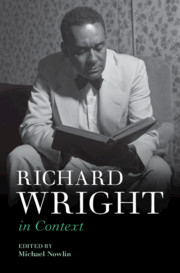Book contents
- Richard Wright in Context
- Richard Wright in Context
- Copyright page
- Contents
- Figures
- Contributors
- Abbreviations
- Richard Wright’s Works: A Chronology
- Introduction Richard Wright’s Luck
- Part I Life and Career, Times and Places
- Part II Social and Cultural Contexts
- Chapter 6 Black Masculinity
- Chapter 7 Wright and African American Women
- Chapter 8 He Tried to Be a Communist
- Chapter 9 Liberalism and the Color Line
- Chapter 10 “The Same Stuff”
- Chapter 11 Moviegoers and Cinematic Seers in Wright’s Fiction
- Chapter 12 Clothing
- Chapter 13 “Defeat Measured in the Jumping Cadences of Triumph”
- Chapter 14 Wright and Religion
- Chapter 15 Bandung and Third-World Liberation
- Chapter 16 Black Paris, Hard-Boiled Paranoia, and the Cultural Cold War
- Part III Literary and Intellectual Contexts
- Part IV Reputation and Critical Reception
- Index
Chapter 13 - “Defeat Measured in the Jumping Cadences of Triumph”
Wright’s Engagements with Blues and Jazz
from Part II - Social and Cultural Contexts
Published online by Cambridge University Press: 08 July 2021
- Richard Wright in Context
- Richard Wright in Context
- Copyright page
- Contents
- Figures
- Contributors
- Abbreviations
- Richard Wright’s Works: A Chronology
- Introduction Richard Wright’s Luck
- Part I Life and Career, Times and Places
- Part II Social and Cultural Contexts
- Chapter 6 Black Masculinity
- Chapter 7 Wright and African American Women
- Chapter 8 He Tried to Be a Communist
- Chapter 9 Liberalism and the Color Line
- Chapter 10 “The Same Stuff”
- Chapter 11 Moviegoers and Cinematic Seers in Wright’s Fiction
- Chapter 12 Clothing
- Chapter 13 “Defeat Measured in the Jumping Cadences of Triumph”
- Chapter 14 Wright and Religion
- Chapter 15 Bandung and Third-World Liberation
- Chapter 16 Black Paris, Hard-Boiled Paranoia, and the Cultural Cold War
- Part III Literary and Intellectual Contexts
- Part IV Reputation and Critical Reception
- Index
Summary
Richard Wright’s relationship with African American music was fundamentally paradoxical: he was both thoroughly immersed in and profoundly detached from such genres as blues and jazz. While he listened to black music avidly, its presence in his fiction is minimal, and—like other progressives and literary figures of his time—he tended to see blues and jazz not as art in themselves, but as vital and raw folk material out of which the literati might create art. What is more, Wright emerged as an author and produced his most canonical works during a relative hiatus in blues history, as well as at a moment when jazz existed primarily as mainstream entertainment in the form of big-band swing. Although critics conventionally focus upon the few fleeting references to African American music in Wright’s fiction, revisionist scholarship might bring the music to bear on the author’s work instead. There are, for example striking parallels of topic, theme, language, and imagery between Wright’s “Down by the Riverside” (1938) and Charley Patton’s song about southern flooding, “High Water Everywhere” (1930). Critics, then, can fill in the blues and jazz gaps in Wright’s work that he was unable to complete himself.
Keywords
- Type
- Chapter
- Information
- Richard Wright in Context , pp. 139 - 149Publisher: Cambridge University PressPrint publication year: 2021

